Greenland

The fourth section of Chapter IV of Immanuel Velikovsky’s Earth in Upheaval is called Greenland. In this section, Velikovsky adduces a number of anomalies—not all exclusive to Greenland—which raise questions concerning the Ice Age Theory as it is conventionally presented.
Greenland is the contemporary example of what, according to the Ice Age theory, happened to a large part of the world in times past ... The Ice Age survived in Greenland. This arctic island reveals how vast continental areas looked in the past. (Velikovsky 38 ... 39)
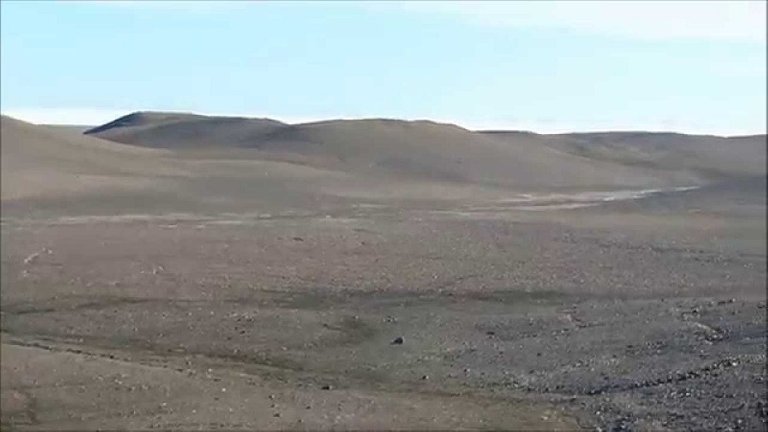
Unglaciated Greenland
The first anomaly Velikovsky discusses is the possibility that the northernmost part of Greenland, Peary Land, was never glaciated:
Probably, then as now, an exception was the northernmost part of Greenland; for it seems a rule that the most northerly lands are not, and never were, glaciated. (Stefansson 4)
Velikovsky also cites the botanist Robert Fiske Griggs, the geologist James Dwight Dana and the clergyman D Gath Whitley to the effect that the Arctic Islands, the interior of Alaska and the lowlying lands of northern Siberia were never glaciated during the last Ice Age.
Griggs is best known as the leader of an expedition to study the aftermath of the 1912 Novarupta-Katmai eruption in southwestern Alaska. We have already met James Dana: Velikovsky cited his Manual of Geology in Chapter One’s The Ivory Islands. In that section, Velikovsky also cited Whitley’s paper, ascribing it to Volume XII instead of Volume XLII, a mistake he repeats in this chapter.
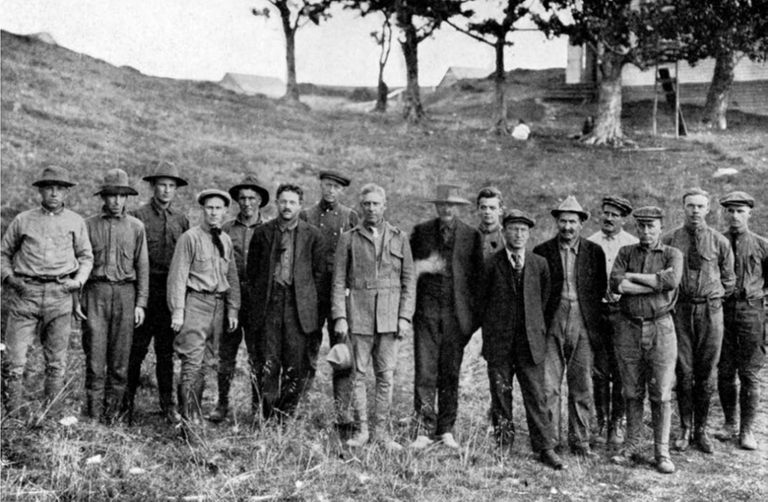
If Velikovsky had wanted to bolster the claim that parts of Greenland remained unglaciated throughout the Pleistocene Ice Age, he would have had little difficulty tracking down a plethora of independent sources:
The existence of unglaciated areas during the last Ice Age was first confirmed geologically by Vogt (1913) ... Turning over to Greenland, already in 1879 Kornerup had suggested the existence of unglaciated areas in western Greenland during the last Ice Age. This view was taken up by Warming (1888) and later by many others for almost all parts of Greenland (see e.g. Gelting, 1934). Of special interest is the statement of Koch (1928) that northernmost Peary Land (northernmost part of Greenland) was never glaciated. (Dahl 225 ... 227)
There is a general consensus that not only northern Greenland but also many other areas of the Arctic and subarctic remained ice free during the Last Ice Age. Uniformitarians try to account for this by claiming that there was simply too little precipitation in these regions for ice sheets to accumulate, but it is difficult to see how this could have been the case over such a vast stretch of land:
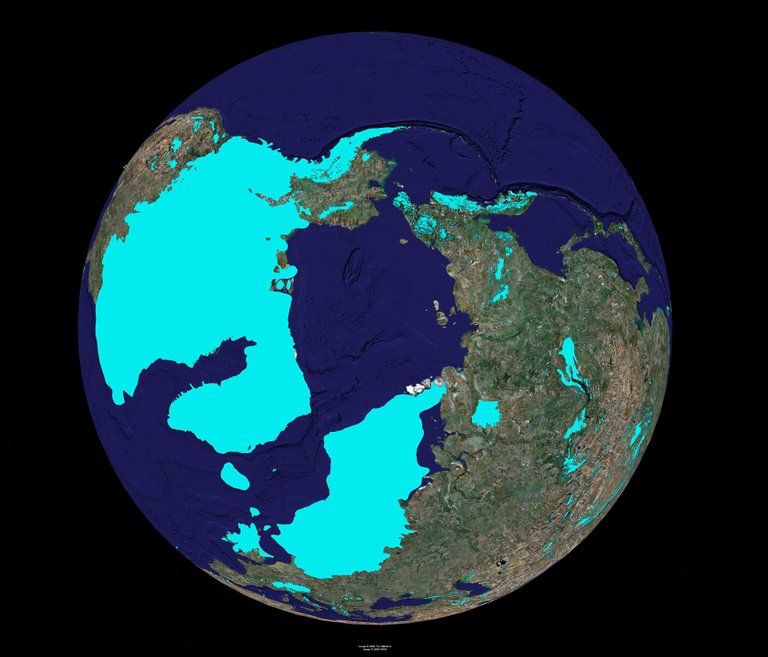
Inconsistent Glaciation
The second anomaly addressed by Velikovsky concerns inconsistencies in the timeline of glaciation found across the northern hemisphere during the Last Ice Age:
Bones of Greenland reindeer have been found in southern New Jersey and southern France, and bones of Lapland reindeer in the Crimea. This was explained as due to the invasion of ice and the retreat of northern animals to the south. The hippopotamus was found in France and England and the lion in Alaska. To explain similar occurrences, an interglacial period was introduced into the scheme: the land was warmed up and the southern animals visited northern latitudes. And since the change from one fauna to another took place repeatedly, four glacial periods with three interglacial were generally counted, though the number of periods is not consistent with all lands or with all investigators. (Velikovsky 39)
Velikovsky does not cite any sources for these details, though Dana’s Manual of Geology does mention one of them:
Further evidence of a partial return of the cold consists in the occurrence in southern France of remains of arctic and subarctic Mammals, among which the Reindeer was prominent. (Dana 997)
When the Ice Age Theory was first proposed, it was thought that there had been only one recent glacial period, But as more evidence was uncovered, the idea of a periodic Ice Age emerged, with two or more glacial periods separated by warmer interglacial periods. In the 1950s, when Velikovsky wrote Earth in Upheaval, there was a general consensus that there had been four principal glacial periods:
In most areas in the Northern Hemisphere where glaciations occurred, we have signs of separate Ice Ages interrupted by interglacial periods. In Europe and Northern America one Ice Age occurred in relatively recent times (20,000-30,000 years ago) which is called the Last Ice Age. The Last Ice Age was preceded by an interglacial, the Last Interglacial, which ... is estimated to have lasted approximately 60,000 years ... The Last Interglacial was preceded by an Ice Age of greater extent than the last, the Great Ice Age. Before the Great Ice Age there was a long interglacial period, the Great Interglacial, which ... was estimated to have lasted 240,000 years. Before the Great Interglacial come one or more glacial periods ... (Dahl 228)
As the second half of the 20th century wore on, however, this simple model became increasingly inadequate to explain all the new data that was being accumulated:
In 1909, A. Penck and E. Brückner defined four Pleistocene glacial maxima on the basis of their observations in the Bavarian Alps. These glacial periods were named (from oldest to youngest) the Günz, Mindel, Riss and Würm. This four-phase scheme was subsequently extended to all parts of Europe. Similar systems were adopted for other northern continents, and the four glacial periods were thought to correspond to “pluvials” (periods of increased rainfall) in Africa. But over the years, it became increasingly clear that this scheme was far too simplistic and that the whole Pleistocene world did not march in time to the same four-beat pattern (Van Couvering 2000b). (Cartmill & Smith 13)
In Ireland, for example, there is evidence for only three major glacial and interglacial stages, known locally as the Munsterian, the Gortian Interglacial and the Midlandian (Warren 315-332). Contrast this with our sister island, Great Britain, where at least six stages have been attested:
| Years BP | Ireland | Britain |
|---|---|---|
| 800 000 - 478 000 | - | Cromerian |
| 478 000 - 424 000 | - | Anglian |
| 424 000 - 374 000 | - | Hoxnian |
| 374 000 - 130 000 | Munsterian | Wolstonian |
| 130 000 - 115 000 | Gortian | Ipswichian |
| 115 000 - 011 700 | Midlandian | Devensian |
Glacial Stages in Britain and Ireland
It is possible, of course, that traces of the Cromerian, Anglian and Hoxnian have simply not yet been discovered in Ireland. Some researchers believe that the Gortian Interglacial corresponds to the Hoxnian Stage, not the later Ipswichian (Warren 315-322). It is also possible that the model of glaciation in Britain needs to be simplified, which would bring it into line with the Irish model:
The conventional wisdom recognizes three major glaciations [in Britain]—Anglian, Wolstonian and Devensian, each being accorded stage status. Yet the view is gaining ascendancy that the products of what have hitherto been interpreted as totally separate Anglian and Wolstonian glaciations are in reality parts of a single glacial complex which in time corresponds to the Anglian Stage (Sumbler 1983). (Worsley 90)

Subtropical Greenland
The third major anomaly addressed by Velikovsky in this section concerns the discovery of fossils of subtropical plants in northern Greenland:
Greenland presents still another enigma in the preceding formations, those of the Tertiary Age. In the 1860s, O. Heer of Zurich published his classical work on the fossil plants of the Arctic; he identified the plant remains of the northern parts of Greenland as magnolia and fig trees, among other species. Forests of exotic trees and groves of juicy subtropical plants grew in the land that lies deep in the cold Arctic and is immersed yearly in a continuous polar night of six months’ duration. (Velikovsky 40)

Oswald Heer was a Swiss botanist. Like D Gath Whitley, he was also a Protestant clergyman. Velikovsky cites his work on the Miocene flora of the Arctic regions—specifically the fossil plant remains brought back from Northwest Greenland by the Danish geologist Knud Johannes Vogelius Steenstrup. This treatise is in German and I have not found an English translation online. But a few years earlier, Heer had prepared a lecture on the same subject, entitled Contributions to the Fossil Flora of North Greenland, Being a Description of the Plants Collected by Mr Edward Whymper during the Summer of 1867. This was communicated to the Royal Society in London on 11 March 1869 by the Irish physicist George Stokes:
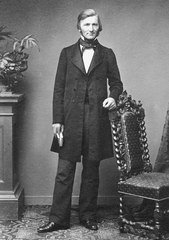
The greater part of the fossil plants which have been brought from Arctic regions have come from North Greenland. Atanekerdluk (lat. 70° N.) is the principal locality, and there the remains of vegetable organisms are found in such profusion, that we are able, to some extent, to restore the ancient flora of North Greenland, and deduce most important conclusions as to the former physiognomy and the climate of this high northern region ... Of the Sequoia Langsdorfii I found the male and female flowers, and the opened cones are not rare. They and the long shoots which are occasionally found, show us that the climate and soil must have been very favourable for the growth of this tree ... The long slender shoots [of Sequoia Couttsiae], figured in Plate XLI, prove that the climate must have been very favourable to these trees (Heer 1869: 445 ... 458 ... 465)
Heer identified about 80 plant species from three dozen taxonomical groups (many of which are now obsolete and have been replaced with revised clades):
Filices, the class of ferns.
Equisetaceae, the horsetail family.
Cupressineae, the tribe of cypresses.
Abietineae, the tribe of pines, firs, larches, cedars and other types of trees.
Taxineae, a suborder of conifers that includes yews and nutmegs.
Gramineae, the grass family.
Cyperaceae, the sedge family.
Smilaceae, the greenbrier family.
Typhaceae, the cattail family.
Naiadeae, a family of aquatic plants.
Styracifulae, the sweetgum family.
Salicineae, the willow family.
Betulaceae, the birch family.
Cupuliferae, the family that includes beeches and oaks.
Ulmaceae, the elm family.
Moreae, the mulberry tribe.
Plataneae, the tribe of plane trees.
Laurineae, the laurel family.
Proteaceae, a family of evergreen trees and shrubs, which are found today predominantly in the Southern Hemisphere (Australia, South Africa, Central Africa, South and Central America, India, eastern and south eastern Asia, and Oceania).
Ebenaceae, a family of trees, including the ebony and persimmon.
Gentianeae, the gentian family.
Caprifoliaceae, a family of shrubs that includes the honeysuckle.
Araliaceae, a family of plants that includes the ivy.
Corneae, the dogwood family.
Ampelideae, the order that includes the grapevine and the Virginia creeper.
Magnoliaceae, the magnolia family.
Menispermaceae, the moonseed family.
Sterculiaceae, the family that includes the cacao tree.
Ilicineae, the holly family.
Celastrineae, the staff vine or bittersweet family.
Rhamneae, the buckthorn family.
Anacardiaceae, the cashew family.
Juglandeae, the walnut family.
Pomaceae, the rose family.
Amygdaleae, a genus that includes the plum, cherry, peach, nectarine, apricot and almond trees.
Leguminosae, the legume family.
Although these plants flourished during an epoch that lasted for about eighteen million years (23 Mya to 5 Mya), it is still difficult to reconcile their presence with the alleged Arctic or subarctic position of Greenland throughout the Miocene.
Curiously, Velikovsky does not discuss this matter any further, though it is arguably the strongest piece of evidence for catastrophism in this section. The Tertiary Period began about 66 Mya. By that time, the continents had drifted into nearly their present configuration, so uniformitarians cannot claim that the northern parts Greenland were then located much closer to the equator. The subtropical plants identified by Heer flourished in Peary Land at a time when—according to the uniformitarians—Peary Land had already reached the Arctic Ocean. In fact, throughout the whole of the Tertiary Period, the northern regions of Greenland lay within the Arctic Circle.
Uniformitarians have been hard pressed to account for these fossils. One approach is to backdate the remains to the Eocene epoch (56-34 Mya), which still leaves them in the Tertiary, and to assign them to different climatic zones:
Failure to take into consideration the existence of climatic zones during the Tertiary period, and to interpret floras from high latitudes as older than those of similar composition from middle latitudes, was to continue for several decades ... Heer had been for so many years committed to the idea of uniform climate and cosmopolitan northern floras that he was wholly unable to analyze objectively the time-space relations of Tertiary vegetation. Even down to our day, the idea of tropical climate at high latitudes has its adherents, with resultant need for drifting continents, wandering poles, or other hypotheses unsupported by the fossil plant records of the Cenozoic era. (Chaney 192)
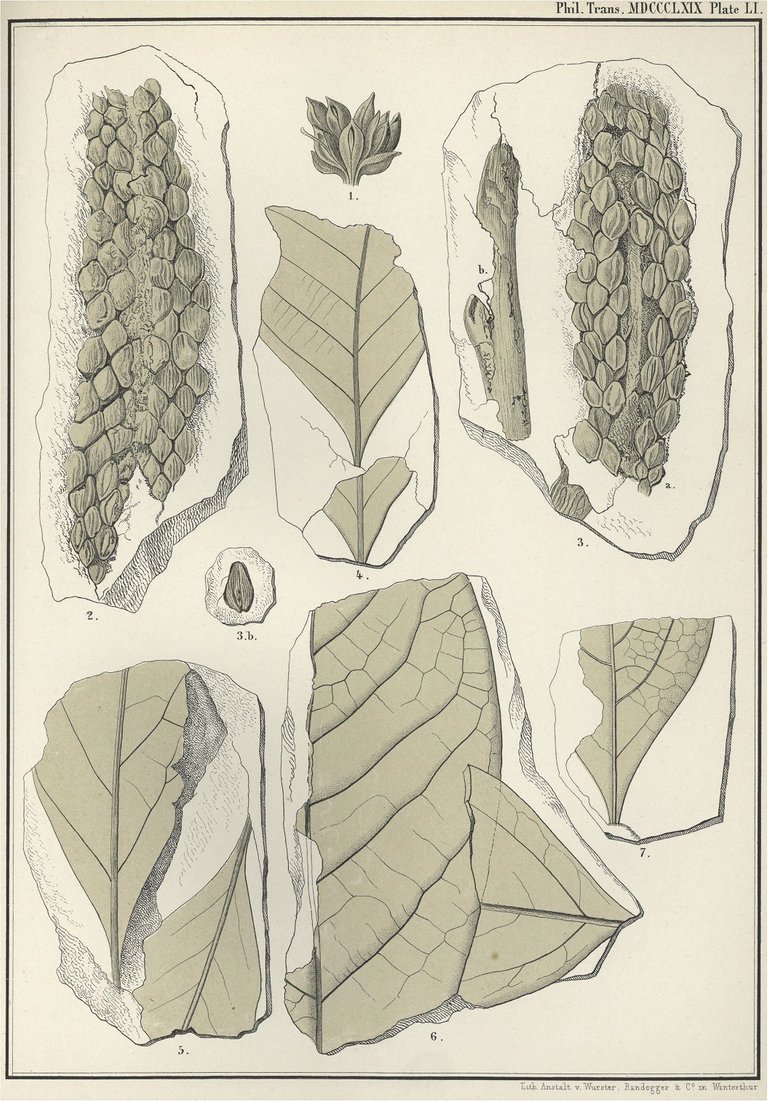
Unexplored Mysteries
Curiously, it never occurs to Velikovsky to question why Greenland alone of the Arctic lands has remained so heavily glaciated to this day. When the Last Ice Age ended and the northern lands experienced almost complete deglaciation, why was Greenland spared? Why did the Ice Age continue unabated on this island down to the present day?
Or if Greenland did become deglaciated at the end of the Ice Age—along with Canada, Scandinavia and the Britannic Isles—how did it become so heavily glaciated again within the past few millennia?
In Chapter 8, Velikovsky will return to the question of Ice Ages and their causes.
References
- Matt Cartmill, Fred H Smith, The Human Lineage, John Wiley & Sons, Inc, Hoboken NJ (2009)
- Ralph W Chaney, A Revision of Fossil Sequoia and Taxodium in Western North America Based on the Recent Discovery of Metasequoia, Transactions of the American Philosophical Society, New Series, Volume 40, Number 3, pp 171-263, American Philosophical Society, Philadelphia (1950)
- Eilif Dahl, On Different Types of Unglaciated Areas During the Ice Ages and their Significance to Phytogeography, New Phytologist, Volume 45, Issue 2, pp 225-242, Cambridge University Press, Cambridge (1946)
- James Dwight Dana, Manual of Geology: Treating of the Principles of the Science with Special Reference to American Geological History, for the Use of Colleges, Academies, and Schools of Science, Fourth Edition, American Book Company, New York (1895)
- Robert Fiske Griggs, Indications as to Climatic Changes from the Timberline of Mount Washington, Science, Volume 95, Number 2473 (May 22), pp 515-519, The Science Press, Lancaster PA (1942)
- Oswald Heer, Contributions to the Fossil Flora of North Greenland, Being a Description of the Plants Collected by Mr Edward Whymper during the Summer of 1867, Philosophical Transactions of the Royal Society, Volume 159, pp 445-488, The Royal Society, London (1869)
- Oswald Heer, Flora Arctica Fossilis: Die fossile Flora der Polarländer, Druck und Verlag von Friedrich Schulthess, Zürich (1868)
- Adolf E Nordenskiöld, Account of an Expedition to Greenland in the Year 1870, Geological Magazine, Volume 9, Issue 97, pp 289-306, 355-368, 409-427, 516-524, Trübner & Co, London (1872)
- Vilhjalmur Stefansson, Greenland, Doubleday, Doran & Co, Inc, New York (1942)
- Immanuel Velikovsky, Earth in Upheaval, Pocket Books, Simon & Schuster, New York (1955, 1977)
- William P Warren, The Stratigraphic Position and Age of the Gortian Interglacial Deposits, Geological Survey of Ireland Bulletin, Volume 2, Number 4, pp 315-332, Dublin (1979)
- D Gath Whitley, The Ivory Islands in the Arctic Ocean, Journal of the Transactions of the Victoria Institute, or, Philosophical Society of Great Britain, Volume 42, pp 35-57, The Victoria Institute, London (1879)
- Peter Worsley, Permafrost Stratigraphy in Britain: A First Approximation, in John Boardman (editor), Periglacial Processes and Landforms in Britain and Ireland, Cambridge University Press, Cambridge (1987)
- George Frederick Wright, The Ice Age in North America and Its Bearing upon the Antiquity of Man, D Appleton and Company, New York (1905)
Image Credits
- Greenland: © Halorache (photographer), Creative Commons License
- Peary Land, Northern Greenland: © Magasinet Polarfronten, Fair Use
- Members of the Novarupta-Katmai Expedition (Griggs is Sixth from the Left): National Geographic Society Katmai Expeditions Photographs, Archives and Special Collections, Consortium Library, University of Alaska Anchorage, 5138 ECK, Public Domain
- The Extent of the Last Glacial Maximum in the Northern Hemisphere: © 2006 TerraMetrics, © 2006 NASA, Fair Use
- Stratigraphic Model of Irish Glaciation (Warren 328): © 1977 W P Warren, Fair Use
- Continental Drift in the Miocene Epoch: © 2004 C R Scotese, Plate Tectonics and Paleogeography (animation), PALEOMAP Project, University of Texas at Arlington, Arlington, TX, Fair Use
- Owald Heer: ETH Library, Public Domain
- Miocene Fossil Flora from Greenland: Oswald Heer (artist), Lithographic Printing House of Wurster, Randegger and Co, Winterthur, Zürich, Switzerland, Public Domain

That's very interesting. Thanks for sharing :)
!discovery 35
This post was shared and voted inside the discord by the curators team of discovery-it
Join our community! hive-193212
Discovery-it is also a Witness, vote for us here